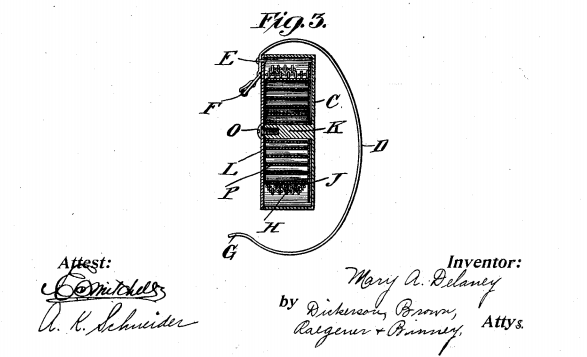Perhaps one of the most helpful innovations in dog care technology was the invention of the extendable (or retractable) dog lead, but how can dog owners go about using it safely?
Believe it or not, the extendable dog lead was conceived way back in 1908! An American woman named Mary A. Delaney, filed a patent called a “leading device” and this was the first extendable dog lead patent. The patent described a drum-like device that used springs to retract the lead, and was accompanied by this diagram:

As the older of us will remember, retractable dog leads never really took off until later in the century – it wasn’t until the 1970’s that extendable leads became readily available and later yet when they would become commonplace. However, Mary’s patent was referenced in eight subsequent patents over the years – indeed, she could be considered to be a…wait for it…leader in her field.
Mary clearly identified a problem with conventional dog leads though, and this inspired the design she created. She outlines this problem in her patent – I’m sure it will seem very familiar to many dog owners:
It is usually desirable that the dog should have a certain freedom in running about, but it is difficult to prevent the animal from running on the wrong side of lamp posts or pedestrians, thus causing much annoyance to the owner, who is constantly required to adjust the length of the leash in her hand and frequently the leash is dropped and the dog permitted to run away. In order to prevent the dog from taking a long course in running about it is necessary to quickly wrap the cord or chain around the hand and unwrap it again after the object has passed, which is an awkward performance when obliged to be done frequently.
It’s curious to consider that even in the prim and proper era of the early 1900’s, dogs were still inflicting the same chaos on our lives as they do now. Of course, we’ve since taken the time to invent a few products that can help us cope with the chaos much better. Or so we have been led to believe. Perhaps, our dogs are the ones that have been training us? After all, in a hundred years, we’re still facing the same trials and tribulations as our ancestors, but our dogs are relatively well-kept in comparison to theirs…
Safety tips for managing your dog on an extendable lead
Giving your canine friend a bit more freedom while you’re out and about is great, but remember it is important to set rules and boundaries for your dog to ensure they are well-behaved. Here are some tips to get you started.
Multiple dogs are for pros; not amateurs like you
Let’s face it. If you’re reading this it’s because you need a bit of help managing your dog. Let’s learn to walk before we sprint off, eh? As all good Ghostbusters know, you should never cross streams and the same goes for walking multiple dogs on extendable leads. Things only have to get a bit tangled before it’s gets complicated for you (and passers by)!
Keep it consistent
Routines make it easier for dogs to learn new behaviours, so keep it consistent when you’re out walking.
- Retract the lead when approaching a busy road to cross, or when there are other dogs nearby.
- Keep a relatively short lead when walking on a narrow pavement (to allow space for runners to pass, for example).
- Give your dog more space when you are in open parks or beaches.
Over time your dog will learn how much space it has in a particular situation and this should help control their behaviour.
Don’t let them pull
If your dog is constantly pulling on the lead it can cause them discomfort, so that’s definitely a behaviour you want to change. We wrote an article on this a few months ago – check it out: How do I stop my dog pulling on the lead?
Be wary of long hair
You are in control of the lead and in particular, when it retracts, so if you have a long-haired dog be careful of catching their hair. It shouldn’t be too much of an issue (it’s more likely to affect them when putting on a harness), but just be careful anyway. And, if you have long hair yourself, be especially careful because freak accidents can happen!
Know your surroundings
With a longer lead between you and your dog, comes many more potential obstacles it can get caught on. From park benches to bushes to lamp posts to other dog walkers, the opportunities to get wrapped up with something or someone are endless. Keep an eye on your dog’s trajectory and train them to move back to you to avoid obstacles.
And finally, as a cyclist, I ask…
…please be conscious of cyclists and runners if you’re walking your dog on cycle paths or other areas used for exercise. You wouldn’t believe how many times I’ve nearly come off my bike because a dog is at one side of the path and the owner is at the other!
The Dog Zone is where dog owners can go to get general tips, advice on their dog’s health and help training their dogs.
Also, check out our dog toy reviews:
We’ve compared a range of products such as dog harnesses, dog beds, interactive dog toys, rope toys, cooling mats and dog coats.
Thanks for this. Agree with you that for a cyclist approaching this situation it is an issue. You have probably discovered that dogs cannot hear what is behind them. So when you are cycling and almost upon them they are startled, and can react aggressively. A ding with the bell can help but the owners then get aggressive!